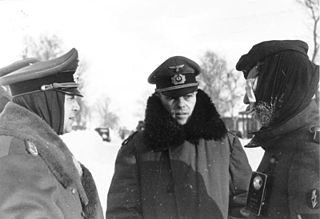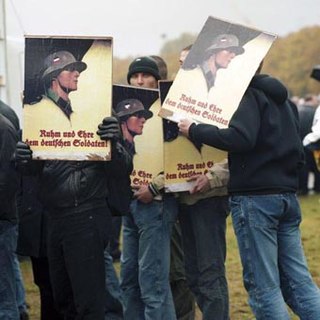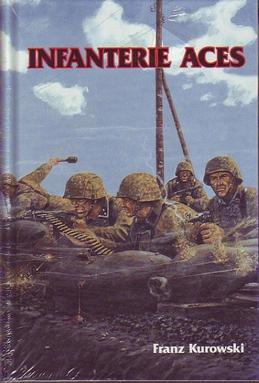
Michael Wittmann was a German Waffen-SS tank commander during the Second World War. He is known for his ambush of elements of the British 7th Armored Division during the Battle of Villers-Bocage on 13 June 1944. While in command of a Tiger I tank, Wittmann was claimed to have destroyed up to 14 tanks, 15 personnel carriers and two anti-tank guns within 15 minutes for the loss of his own tank. The news was disseminated by Nazi propaganda and added to Wittmann's reputation.

Franz Bäke was a German officer and tank commander during World War II. He was a recipient of the Knight's Cross of the Iron Cross with Oak Leaves and Swords of Nazi Germany. In post-war popular culture, Bäke was memorialised in the historical fiction series Panzer Aces by German author Franz Kurowski.
The Panzergrenadier Division "Großdeutschland", also commonly referred to simply as Großdeutschland or Großdeutschland Division, was an elite combat unit of the German Army that fought on the Eastern Front in World War II.

Friedrich von Mellenthin was a German general during World War II. A participant in most of the major campaigns of the war, he became known afterwards for his memoirs Panzer Battles, first published in 1956 and reprinted several times since then.

Panzer Battles is the English language title of Friedrich von Mellenthin's memoirs of his service as a staff officer in the Panzerwaffe of the German Army during World War II.

Ernst Barkmann was a German tank commander in the Waffen-SS of Nazi Germany during World War II. He is known for the actions undertaken at “Barkmann’s Corner", in which it is claimed he halted a major U.S. Army armoured advance in Normandy on 27 July 1944, for which he received the Knight's Cross of the Iron Cross.
Schiffer Publishing Ltd. is a family-owned publisher of nonfiction books. Founded in 1974 and based in Atglen, Pennsylvania, its coverage includes antiques, architecture and design, arts and crafts, collectibles, lifestyle, children's books, regional, military history, militaria, tarot and oracle, and mind, body, and spirit.

Richard Ruoff was a general in the Wehrmacht of Nazi Germany during World War II. He commanded the 4th Panzer Army and the 17th Army on the Eastern Front.
Panzer ace is a contemporary term used in English-speaking popular culture to describe highly decorated German tank ("panzer") commanders and crews during World War II. The Wehrmacht as well as British and American militaries did not recognise the concept of an "ace" during the war. The similar term, tank ace has been used post-war to describe highly regarded tanks commanders.

Verlorene Siege is the personal narrative of Erich von Manstein, a German field marshal during World War II. The book was first published in West Germany in 1955, then in Spain in 1956. Its English translation was published in 1958 for distribution in the UK and the US.
Trevor James Constable was an early UFO writer who believed that the UFO phenomenon was best explained by the presence of enormous amoeba-like animals inhabiting earth's atmosphere. A native of Wellington, New Zealand, he served 31 years at sea, 26 of them as a radio officer in the U.S. merchant marine. He authored several books on the aerial warfare of World War II, together with co-author Raymond Toliver. These works have been described as uncritical and not grounded in historical realities by several historians.
Ronald Smelser is an American historian, author, and former professor of history at the University of Utah. He specializes in modern European history, including the history of Nazi Germany and the Holocaust, and has written several books on these topics. Smelser is the author, together with fellow historian Edward J. Davies, of the 2008 book The Myth of the Eastern Front: The Nazi-Soviet War in American Popular Culture.

Franz Kurowski was a German author of fiction and non-fiction who specialised in World War II topics. He is best known for producing apologist, revisionist and semi-fictional works on the history of the war, including the popular English-language series Panzer Aces and Infantry Aces.

The myth of the clean Wehrmacht is the negationist notion that the regular German armed forces were not involved in the Holocaust or other war crimes during World War II. The myth, heavily promoted by German authors and military personnel after World War II, completely denies the culpability of the German military command in the planning and perpetration of war crimes. Even where the perpetration of war crimes and the waging of an extermination campaign, particularly in the Soviet Union – where the Nazis viewed the population as "sub-humans" ruled by "Jewish Bolshevik" conspirators – has been acknowledged, they are ascribed to the "Party soldiers corps", the Schutzstaffel (SS), but not the regular German military.

The Myth of the Eastern Front: The Nazi–Soviet War in American Popular Culture (2008) by Ronald Smelser and Edward J. Davies, is a historical analysis of the post-war myth of the "Clean Wehrmacht", the negative impact of the Wehrmacht and the Waffen-SS mythologies in popular culture, and the effects of historical negationism upon cultural perceptions of the Eastern Front of the Second World War.
The Waffen-SS, the combat branch of the paramilitary SS organisation of Nazi Germany, is often portrayed uncritically or admiringly in popular culture.
J.J. Fedorowicz Publishing is a Canadian publishing house that specialises in literature on the German armed forces of the World War II era. Its authors are both popular history writers such as Paul Carell and Franz Kurowski, along with the war-time veterans, including Kurt Meyer of the SS Division Hitlerjugend and Otto Weidinger of the SS Division Das Reich.
Edward J. Davies is an American historian, author, and professor of history at the University of Utah. He specialises in modern American history and has written several books on the subject. Davies is the author, together with fellow historian Ronald Smelser, of the 2008 book The Myth of the Eastern Front: The Nazi-Soviet War in American Popular Culture.

Infantry Aces is an English-language book by the German author Franz Kurowski. Originally released by the Canadian publisher of militaria literature J.J. Fedorowicz Publishing, it was later licensed by Fedorowicz to the American publishers Ballantine Books and Stackpole Books. The book was a commercial success and enjoyed a wide readership among the American public.
Mark C. Yerger was an American author of books about the Schutzstaffel and Waffen-SS of Nazi Germany. He had close contacts to SS veterans, through whom he was able to access private archives, and wrote biographies of commanders and award recipients of the SS and of SS units. Historians of World War II have described Yerger's work as uncritical, hagiographic and whitewashing towards the SS.











